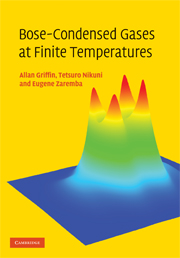Book contents
- Frontmatter
- Contents
- Preface
- 1 Overview and introduction
- 2 Condensate dynamics at T = 0
- 3 Coupled equations for the condensate and thermal cloud
- 4 Green's functions and self-energy approximations
- 5 The Beliaev and the time-dependent HFB approximations
- 6 Kadanoff–Baym derivation of the ZNG equations
- 7 Kinetic equation for Bogoliubov thermal excitations
- 8 Static thermal cloud approximation
- 9 Vortices and vortex lattices at finite temperatures
- 10 Dynamics at finite temperatures using the moment method
- 11 Numerical simulation of the ZNG equations
- 12 Simulation of collective modes at finite temperature
- 13 Landau damping in trapped Bose-condensed gases
- 14 Landau's theory of superfluidity
- 15 Two-fluid hydrodynamics in a dilute Bose gas
- 16 Variational formulation of the Landau two-fluid equations
- 17 The Landau–Khalatnikov two-fluid equations
- 18 Transport coefficients and relaxation times
- 19 General theory of damping of hydrodynamic modes
- Appendix A Monte Carlo calculation of collision rates
- Appendix B Evaluation of transport coefficients: technical details
- Appendix C Frequency-dependent transport coefficients
- Appendix D Derivation of hydrodynamic damping formula
- References
- Index
5 - The Beliaev and the time-dependent HFB approximations
Published online by Cambridge University Press: 06 October 2009
- Frontmatter
- Contents
- Preface
- 1 Overview and introduction
- 2 Condensate dynamics at T = 0
- 3 Coupled equations for the condensate and thermal cloud
- 4 Green's functions and self-energy approximations
- 5 The Beliaev and the time-dependent HFB approximations
- 6 Kadanoff–Baym derivation of the ZNG equations
- 7 Kinetic equation for Bogoliubov thermal excitations
- 8 Static thermal cloud approximation
- 9 Vortices and vortex lattices at finite temperatures
- 10 Dynamics at finite temperatures using the moment method
- 11 Numerical simulation of the ZNG equations
- 12 Simulation of collective modes at finite temperature
- 13 Landau damping in trapped Bose-condensed gases
- 14 Landau's theory of superfluidity
- 15 Two-fluid hydrodynamics in a dilute Bose gas
- 16 Variational formulation of the Landau two-fluid equations
- 17 The Landau–Khalatnikov two-fluid equations
- 18 Transport coefficients and relaxation times
- 19 General theory of damping of hydrodynamic modes
- Appendix A Monte Carlo calculation of collision rates
- Appendix B Evaluation of transport coefficients: technical details
- Appendix C Frequency-dependent transport coefficients
- Appendix D Derivation of hydrodynamic damping formula
- References
- Index
Summary
Single-particle Green's functions, density response functions and other correlation functions are calculated in many different ways in the literature on Bose-condensed gases. An in-depth comparison and classification of different approaches was first given in the classic paper by Hohenberg and Martin (1965), with an emphasis on the various exact identities (conservation laws) that are satisfied. A key feature to be included in any theory is that a Bose broken symmetry leads to a hybridization of the single-particle excitations and the collective density fluctuations in such a way that the two excitation spectra become identical. This key feature is demonstrated in Chapter 5 of Griffin (1993).
How to relate and assess various approximations for correlation functions in a Bose superfluid has been a topic of continual interest (and some controversy) since the late 1950s. These questions were largely resolved by the early 1960s at a conceptual level but the detailed applications of the theory were limited to dilute Bose-condensed gases at T = 0. Since it was difficult to relate the theory to the properties of superfluid. He at a quantitative level, this formalism based on a Bose broken symmetry was of little interest to experimentalists. The creation of superfluid Bose condensed gases in 1995 changed all this and has given new life to the many body theory of dilute weakly interacting Bose condensed gases.
Various approximations for the Beliaev single-particle self-energies Σαβ were derived in Sections 4.3 and 4.4. The discussion in Chapter 4 was somewhat abstract.
- Type
- Chapter
- Information
- Bose-Condensed Gases at Finite Temperatures , pp. 81 - 106Publisher: Cambridge University PressPrint publication year: 2009



